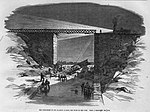Waterdown District High School
1993 establishments in OntarioEducational institutions established in 1993High schools in Hamilton, Ontario
Waterdown District High School is located at 215 Parkside Drive, Waterdown, Ontario, and is a member of the Hamilton-Wentworth District School Board.
Excerpt from the Wikipedia article Waterdown District High School (License: CC BY-SA 3.0, Authors).Waterdown District High School
Parkside Drive, Hamilton Waterdown
Geographical coordinates (GPS) Address Phone number External links Nearby Places Show on map
Geographical coordinates (GPS)
| Latitude | Longitude |
|---|---|
| N 43.33466 ° | E -79.91095 ° |
Address
Waterdown District High School
Parkside Drive 215
L8B 1B9 Hamilton, Waterdown
Ontario, Canada
Open on Google Maps





